重庆医科大学:《内科学》课程教学课件(PPT讲稿)Cardiomyopathies
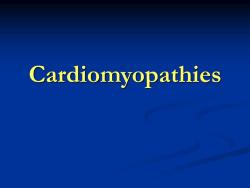
Cardiomyopathies
Cardiomyopathies
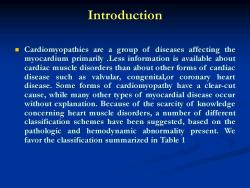
Introduction Cardiomyopathies are a group of diseases affecting the myocardium primarily Less information is available about cardiac muscle disorders than about other forms of cardiac disease such as valvular,congenital,or coronary heart disease.Some forms of cardiomyopathy have a clear-cut cause,while many other types of myocardial disease occur without explanation.Because of the scarcity of knowledge concerning heart muscle disorders,a number of different classification schemes have been suggested,based on the pathologic and hemodynamic abnormality present.We favor the classification summarized in Table 1
Introduction ◼ Cardiomyopathies are a group of diseases affecting the myocardium primarily .Less information is available about cardiac muscle disorders than about other forms of cardiac disease such as valvular, congenital,or coronary heart disease. Some forms of cardiomyopathy have a clear-cut cause, while many other types of myocardial disease occur without explanation. Because of the scarcity of knowledge concerning heart muscle disorders, a number of different classification schemes have been suggested, based on the pathologic and hemodynamic abnormality present. We favor the classification summarized in Table 1
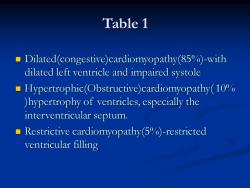
Table 1 Dilated(congestive)cardiomyopathy(85%)-with dilated left ventricle and impaired systole Hypertrophic(Obstructive)cardiomyopathy(10% )hypertrophy of ventricles,especially the interventricular septum. Restrictive cardiomyopathy(5%)-restricted ventricular filling
Table 1 ◼ Dilated(congestive)cardiomyopathy(85%)-with dilated left ventricle and impaired systole ◼ Hypertrophic(Obstructive)cardiomyopathy( 10% )hypertrophy of ventricles, especially the interventricular septum. ◼ Restrictive cardiomyopathy(5%)-restricted ventricular filling
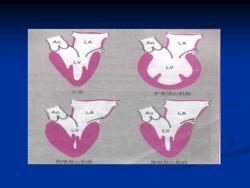
正常 打扩张型心肌病 肥厚型心肌病 限制型心肌闲

Dilated Cardiomyopathy Introduction Dilated cardiomyopathy (DCM)is a syndrome characterized by cardiac enlargement and impaired systolic function of one or both ventricles. Although it was formerly called congestive cardiomyopathy,the term dilated cardiomyopathy is now preferred because the earliest abnormality usually is ventricular enlargement and systolic contractile dysfunction,with congestive heart failure often developing later. ■Epidemiology The incidence of DCM is reported to about 5 to 8 cases per 100,000 population per year and appear to be increasing,although the true figure likely is higher as a consequence of underreporting of mild or asymptomatic cases.It occurs almost three times more frequently in blacks and males than in white and females,and this difference does not appear to be related solely to differing degrees of hypertension, cigarette smoking,or alcohol use;furthermore,survival in blacks appears to be worse than in whites
Dilated Cardiomyopathy ◼ Introduction ◼ Dilated cardiomyopathy (DCM) is a syndrome characterized by cardiac enlargement and impaired systolic function of one or both ventricles. Although it was formerly called congestive cardiomyopathy, the term dilated cardiomyopathy is now preferred because the earliest abnormality usually is ventricular enlargement and systolic contractile dysfunction, with congestive heart failure often developing later. ◼ Epidemiology The incidence of DCM is reported to about 5 to 8 cases per 100,000 population per year and appear to be increasing, although the true figure likely is higher as a consequence of underreporting of mild or asymptomatic cases. It occurs almost three times more frequently in blacks and males than in white and females, and this difference does not appear to be related solely to differing degrees of hypertension, cigarette smoking, or alcohol use; furthermore, survival in blacks appears to be worse than in whites
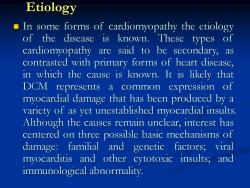
Etiology In some forms of cardiomyopathy the etiology of the disease is known.These types of cardiomyopathy are said to be secondary,as contrasted with primary forms of heart disease, in which the cause is known.It is likely that DCM represents a common expression of myocardial damage that has been produced by a variety of as yet unestablished myocardial insults. Although the causes remain unclear,interest has centered on three possible basic mechanisms of damage:familial and genetic factors;viral myocarditis and other cytotoxic insults;and immunological abnormality
Etiology ◼ In some forms of cardiomyopathy the etiology of the disease is known. These types of cardiomyopathy are said to be secondary, as contrasted with primary forms of heart disease, in which the cause is known. It is likely that DCM represents a common expression of myocardial damage that has been produced by a variety of as yet unestablished myocardial insults. Although the causes remain unclear, interest has centered on three possible basic mechanisms of damage: familial and genetic factors; viral myocarditis and other cytotoxic insults; and immunological abnormality
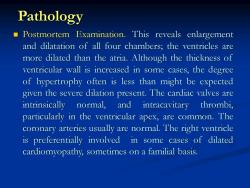
Pathology Postmortem Examination.This reveals enlargement and dilatation of all four chambers;the ventricles are more dilated than the atria.Although the thickness of ventricular wall is increased in some cases,the degree of hypertrophy often is less than might be expected given the severe dilation present.The cardiac valves are intrinsically normal, and intracavitary thrombi, particularly in the ventricular apex,are common.The coronary arteries usually are normal.The right ventricle is preferentially involved in some cases of dilated cardiomyopathy,sometimes on a familial basis
Pathology ◼ Postmortem Examination. This reveals enlargement and dilatation of all four chambers; the ventricles are more dilated than the atria. Although the thickness of ventricular wall is increased in some cases, the degree of hypertrophy often is less than might be expected given the severe dilation present. The cardiac valves are intrinsically normal, and intracavitary thrombi, particularly in the ventricular apex, are common. The coronary arteries usually are normal. The right ventricle is preferentially involved in some cases of dilated cardiomyopathy, sometimes on a familial basis
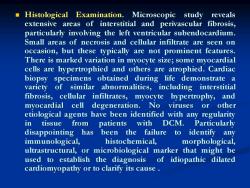
Histological Examination.Microscopic study reveals extensive areas of interstitial and perivascular fibrosis, particularly involving the left ventricular subendocardium. Small areas of necrosis and cellular infiltrate are seen on occasion,but these typically are not prominent features. There is marked variation in myocyte size;some myocardial cells are hypertrophied and others are atrophied.Cardiac biopsy specimens obtained during life demonstrate a variety of similar abnormalities,including interstitial fibrosis,cellular infiltrates,myocyte hypertrophy,and myocardial cell degeneration.No viruses or other etiological agents have been identified with any regularity in tissue from patients with DCM.Particularly disappointing has been the failure to identify any immunological, histochemical, morphological, ultrastructural,or microbiological marker that might be used to establish the diagnosis of idiopathic dilated cardiomyopathy or to clarify its cause
◼ Histological Examination. Microscopic study reveals extensive areas of interstitial and perivascular fibrosis, particularly involving the left ventricular subendocardium. Small areas of necrosis and cellular infiltrate are seen on occasion, but these typically are not prominent features. There is marked variation in myocyte size; some myocardial cells are hypertrophied and others are atrophied. Cardiac biopsy specimens obtained during life demonstrate a variety of similar abnormalities, including interstitial fibrosis, cellular infiltrates, myocyte hypertrophy, and myocardial cell degeneration. No viruses or other etiological agents have been identified with any regularity in tissue from patients with DCM. Particularly disappointing has been the failure to identify any immunological, histochemical, morphological, ultrastructural, or microbiological marker that might be used to establish the diagnosis of idiopathic dilated cardiomyopathy or to clarify its cause
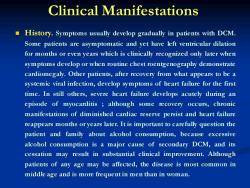
Clinical Manifestations History.Symptoms usually develop gradually in patients with DCM. Some patients are asymptomatic and yet have left ventricular dilation for months or even years which is clinically recognized only later when symptoms develop or when routine chest roentgenography demonstrate cardiomegaly.Other patients,after recovery from what appears to be a systemic viral infection,develop symptoms of heart failure for the first time.In still others,severe heart failure develops acutely during an episode of myocarditis although some recovery occurs,chronic manifestations of diminished cardiac reserve persist and heart failure reappears months or years later.It is important to carefully question the patient and family about alcohol consumption,because excessive alcohol consumption is a major cause of secondary DCM,and its cessation may result in substantial clinical improvement.Although patients of any age may be affected,the disease is most common in middle age and is more frequent in men than in woman
Clinical Manifestations ◼ History. Symptoms usually develop gradually in patients with DCM. Some patients are asymptomatic and yet have left ventricular dilation for months or even years which is clinically recognized only later when symptoms develop or when routine chest roentgenography demonstrate cardiomegaly. Other patients, after recovery from what appears to be a systemic viral infection, develop symptoms of heart failure for the first time. In still others, severe heart failure develops acutely during an episode of myocarditis ; although some recovery occurs, chronic manifestations of diminished cardiac reserve persist and heart failure reappears months or years later. It is important to carefully question the patient and family about alcohol consumption, because excessive alcohol consumption is a major cause of secondary DCM, and its cessation may result in substantial clinical improvement. Although patients of any age may be affected, the disease is most common in middle age and is more frequent in men than in woman
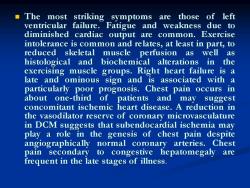
The most striking symptoms are those of left ventricular failure.Fatigue and weakness due to diminished cardiac output are common.Exercise intolerance is common and relates,at least in part,to reduced skeletal muscle perfusion as well as histological and biochemical alterations in the exercising muscle groups.Right heart failure is a late and ominous sign and is associated with a particularly poor prognosis.Chest pain occurs in about one-third of patients and may suggest concomitant ischemic heart disease.A reduction in the vasodilator reserve of coronary microvasculature in DCM suggests that subendocardial ischemia may play a role in the genesis of chest pain despite angiographically normal coronary arteries.Chest pain secondary to congestive hepatomegaly are frequent in the late stages of illness
◼ The most striking symptoms are those of left ventricular failure. Fatigue and weakness due to diminished cardiac output are common. Exercise intolerance is common and relates, at least in part, to reduced skeletal muscle perfusion as well as histological and biochemical alterations in the exercising muscle groups. Right heart failure is a late and ominous sign and is associated with a particularly poor prognosis. Chest pain occurs in about one-third of patients and may suggest concomitant ischemic heart disease. A reduction in the vasodilator reserve of coronary microvasculature in DCM suggests that subendocardial ischemia may play a role in the genesis of chest pain despite angiographically normal coronary arteries. Chest pain secondary to congestive hepatomegaly are frequent in the late stages of illness
按次数下载不扣除下载券;
注册用户24小时内重复下载只扣除一次;
顺序:VIP每日次数-->可用次数-->下载券;
- 重庆医科大学:《内科学》课程教学课件(PPT讲稿)高血压病 PRIMARY HYPERTENTION.ppt
- 重庆医科大学:《内科学》课程教学课件(PPT讲稿)心肌病(附属第二医院心内科:高大中).ppt
- 重庆医科大学:《内科学》课程教学课件(PPT讲稿)心脏瓣膜病(valvular heart disease).ppt
- 重庆医科大学:《内科学》课程教学课件(PPT讲稿)心肌炎(myocarditis).ppt
- 重庆医科大学:《内科学》课程授课教案(七年制)贫血总论 - 陈姝.doc
- 重庆医科大学:《内科学》课程授课教案(七年制)血小板减少性紫癜 - 邓建川.doc
- 重庆医科大学:《内科学》课程授课教案(七年制)胃食管反流病 - 冯晓霞.doc
- 重庆医科大学:《内科学》课程授课教案(七年制)胃炎 - 宁波.doc
- 重庆医科大学:《内科学》课程授课教案(七年制)肾上腺皮质功能亢进 - 程伟.doc
- 重庆医科大学:《内科学》课程授课教案(七年制)肝硬化 - 沈薇.doc
- 重庆医科大学:《内科学》课程授课教案(七年制)肝性脑病 - 沈薇.doc
- 重庆医科大学:《内科学》课程授课教案(七年制)缺铁性贫血 - 陈姝.doc
- 重庆医科大学:《内科学》课程授课教案(七年制)糖尿病 - 龙敏.doc
- 重庆医科大学:《内科学》课程授课教案(七年制)白血病 - 陈林.doc
- 重庆医科大学:《内科学》课程授课教案(七年制)甲亢 - 李荣.doc
- 重庆医科大学:《内科学》课程授课教案(七年制)溶血性贫血 - 周慷.doc
- 重庆医科大学:《内科学》课程授课教案(七年制)淋巴瘤 - 周慷.doc
- 重庆医科大学:《内科学》课程授课教案(七年制)消化道出血 - 陈伟庆.doc
- 重庆医科大学:《内科学》课程授课教案(七年制)消化性溃疡 - 冯晓霞.doc
- 重庆医科大学:《内科学》课程授课教案(七年制)急性胰腺炎 - 陈伟庆.doc
- 重庆医科大学:《内科学》课程教学课件(PPT讲稿)Chronic Renal Failure.ppt
- 重庆医科大学:《内科学》课程教学课件(PPT讲稿)Generalintroductionofrenaldisease.ppt
- 重庆医科大学:《内科学》课程教学课件(PPT讲稿)Glomerulardisease.ppt
- 重庆医科大学:《内科学》课程教学课件(PPT讲稿)HEART FAILURE.ppt
- 重庆医科大学:《内科学》课程教学课件(PPT讲稿)hypertension.ppt
- 重庆医科大学:《内科学》课程教学课件(PPT讲稿)Leukemia(一).ppt
- 重庆医科大学:《内科学》课程教学课件(PPT讲稿)Pericardial diease.ppt
- 重庆医科大学:《内科学》课程教学课件(PPT讲稿)系统性红斑狼疮狼疮性肾炎(Systemic Lupus Erythematosus,SLE).ppt
- 重庆医科大学:《内科学》课程教学课件(PPT讲稿)冠状动脉粥样硬化型心脏病 Coronary Atherosclerotic Heart Disease.ppt
- 重庆医科大学:《内科学》课程教学课件(PPT讲稿)心律失常 Cardiac Arrhythmia.ppt
- 重庆医科大学:《内科学》课程教学课件(PPT讲稿)Leukemia(二).ppt
- 重庆医科大学:《内科学》课程教学课件(PPT讲稿)再生障碍性贫血 Aplastic Anemia.ppt
- 重庆医科大学:《内科学》课程教学课件(PPT讲稿)功能性胃肠病 Functional Gastrointestinal Disorders.ppt
- 重庆医科大学:《内科学》课程教学课件(PPT讲稿)第七篇 内分泌和代谢疾病 第一章 总论.ppt
- 重庆医科大学:《内科学》课程教学课件(PPT讲稿)第七篇 内分泌和代谢疾病 第九章 甲状腺功能亢进症 Hyperthyroidism.ppt
- 重庆医科大学:《内科学》课程教学课件(PPT讲稿)第七篇 内分泌和代谢疾病 第六章 尿崩症.ppt
- 重庆医科大学:《内科学》课程教学课件(PPT讲稿)第七篇 内分泌和代谢疾病 第十三章 库欣综合征(Cushing’s syndrome).ppt
- 重庆医科大学:《内科学》课程教学课件(PPT讲稿)第七篇 内分泌和代谢疾病 第十六章 嗜铬细胞瘤.ppt
- 重庆医科大学:《内科学》课程教学课件(PPT讲稿)第七篇 内分泌和代谢疾病 第十四章 原发性醛固酮增多症.ppt
- 重庆医科大学:《内科学》课程教学课件(PPT讲稿)糖尿病.ppt
